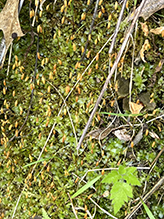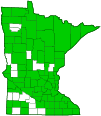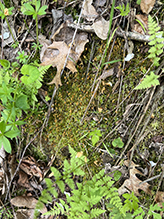toothed plagiomnium moss
(Plagiomnium cuspidatum)
Conservation • Description • Habitat • Ecology • Use • Distribution • Taxonomy
|
|
||||||||||||||
Description |
Toothed plagiomnium moss, also called baby tooth moss and in the UK woodsy thyme-moss, is a common, tuft-forming (acrocarpous) moss. It occurs in Europe, Asia, and North America. It occurs throughout the United States and southern Canada, but it is uncommon from the West Coast through the Great Plains and in the south. In Minnesota, it is common in the forested eastern regions, uncommon in the western prairie region except along wooded river corridors. Toothed plagiomnium moss is found in deciduous and mixed forests, forested peatlands, shrubby areas, savannas, fens, cattail marshes, and river shores. It grows on the ground on soil and on woody debris, and occasionally on tree bases, tree stumps, and soil-covered rocks. It can form a dense mat or an open, often widely spreading tuft. The stems are green or yellowish green when young, and they usually turn brownish as they age. The main, dominant, stem is a vegetative (sterile), creeping, stolon-like, “plagiotropic shoot”. It is unbranched, it lies flat on the ground (prostrate) and it can be up to 2¾″ (7 cm) long. The leaves are arranged on two sides of the stem, not whorled, and they are oriented in a flat plane (complanate). The leaves are smaller at the tip of the stem. There are sometimes numerous, brown, root-like filaments (rhizoids) on the bottom of the stem. The fertile stems are erect, unbranched, and ⅜″ to 1⅜″ (10 to 35 mm) tall, and the leaves are crowded at the top of the stem. The leaves appear to be connected to the stem at the same level, but they are not. The leaves are ⅛″ to 3⁄16″ (3 to 5 mm) long, 1⁄32″ to 1⁄16″ (1 to 2 mm) wide, and usually egg shaped or more or less diamond shaped, occasionally elliptic. They are dark green or yellowish green, somewhat translucent, and spreading when wet, shriveled and contorted when dry. Dry leaves will return to their previous state when moisture is provided. The base of the leaf blade runs far down the stem. There is one midrib (costa), and it is prominent. The tip of the blade is gradually tapered to a long, sharp, flexible point (cusp). The costa extends into the cusp. The cusp is sometimes toothed. Under magnification, the leaf cells can be seen to be short and elongated. They are sometimes arranged in longitudinal rows, rarely in diagonal rows. The cells in the 2 to 4 marginal rows are smaller, linear, and lighter in color. The leaf margin is toothed only on the upper half, the lower half is smooth. The teeth are sharp and prominent. Male and female parts are produced together (synoicous) on each fertile stem. A single spore-bearing reproductive structure (sporophyte) rises from near the tip of each fertile stem. The sporophyte is a small capsule at the end of a long stalk (seta). The seta is ¾″ to 1 3⁄16″ (2 to 3 cm) long, slender, smooth, and yellow, brown, or sometimes reddish. The capsule is egg shaped or cylinder shaped, drooping (pendant), and 1⁄16″to ⅛″ (2 to 3.5 mm) long. It is green at first, soon becoming yellow or yellowish brown. |
Growth Form |
Acrocarp |
Height |
⅜″ to 1⅜″ (10 to 35 mm) |
Similar Species |
Habitat |
Deciduous and mixed forests, forested peatlands, shrubby areas, savannas, fens, cattail marshes, and river shores |
Ecology |
Phenology |
The fruit ripens in late spring. |
Use |
|
Distribution |
||
|
Sources Janssens, J.A. 2014. Noteworthy Mosses & Liverworts of Minnesota, Part II: Species Fact Sheets. Minnesota Department of Natural Resources 2014, 208 pp. |
|
| 4/7/2024 | ||
Nativity |
||
Native |
||
Occurrence |
||
Common and widespread |
||
Taxonomy |
|
| Kingdom | Plantae (green algae and land plants) |
| Subkingdom | Viridiplantae (green plants) |
| Infrakingdom | Streptophyta (land plants and green algae) |
| Superdivision | |
| Division | |
| Subdivision | Bryophytina |
| Class | Bryopsida (joint-toothed mosses) |
| Subclass | Bryidae |
| Superorder | Bryanae |
Order |
Bryales |
Family |
Mniaceae |
Genus |
Plagiomnium (thyme and allied mosses) |
This species was formerly placed in the genus Mnium. It was long known that the genus needed revision. In a generic revision of the family Mniaceae (Koponen, 1968), the author proposed dividing the family into ten genera and the genus Mnium into five genera. Two of those five genera are uncommon, three are widespread and common. Of those three, Plagiomnium leaf margins have single teeth, Mnium leaf margins are double toothed, and Rhizomnium leaf margins have no teeth. |
|
Subordinate Taxa |
|
|
|
Synonyms |
|
Astrophyllum silvaticum Bryum cuspidatum Hypnum aciphyllum Hypnum cuspidatum Mnium affine ssp. humile Mnium affine var. humile Mnium cuspidatum Mnium cuspidatum ssp. eucuspidatum Mnium cuspidatum ssp. pachyphyllum Mnium cuspidatum ssp. parvum Mnium cuspidatum ssp. tenellum Mnium cuspidatum var. cavifolium Mnium cuspidatum var. pachyphyllum Mnium cuspidatum var. tenellum Mnium serpyllifolium var. cuspidatum Mnium silvaticum Mnium silvaticum ssp. cavifolium Mnium silvaticum var. cavifolium Mnium sylvaticum Orthomnion cuspidatum Polla cuspidata |
|
Common Names |
|
baby tooth moss common woodsy plagiomnium moss toothed plagiomnium moss woodsy leafy moss woodsy thyme-moss (UK) |
|
Glossary
Acrocarp
A moss that grows in cushions or tufts; has an upright growth habit; is usually unbranched or sparingly forked; and has the female sporophytes borne at the tips of stems and branches. Adj.: acrocarpous.
Linear
Long, straight, and narrow, with more or less parallel sides, like a blade of grass.
Rhizoid
A filament arising from the lower stem of a moss, liverwort, or alga that anchors it to a substrate.
Seta
A stiff, hair-like process on the outer surface of an organism. In Lepidoptera: A usually rigid bristle- or hair-like outgrowth used to sense touch. In mosses: The stalk supporting a spore-bearing capsule and supplying it with nutrients. Plural: setae. Adjective: setose.
Visitor Photos |
||
Share your photo of this plant. |
||
This button not working for you? |
||
Nancy Falkum |
||
 |
||
MinnesotaSeasons.com Photos |
||
|
||
|
||

Slideshows |
|

Visitor Videos |
||
Share your video of this plant. |
||
This button not working for you? |
||
|
Other Videos |
||
Plagiomnium cuspidatum (toothed or “baby-tooth” plagiomnium moss and woodsy thyme-moss) |
About
May 4, 2023 Most likely, it is Plagiomnium cuspidatum (Hedw.) T. Kop. 100% identification is possible only under the microscope. The main voice is the boreal chorus frog (Pseudacris maculata). As well, far away is the wood frog (Lithobates sylvaticus) |
Plagiomnium cuspidatum, a "baby tooth moss" on a cliff side. Giant city state park. |
About
Jan 30, 2024 https://en.wikipedia.org/wiki/Plagiomnium_cuspidatum |
Title |
About
Měřík bodlavý | Plagiomnium cuspidatum Mecheche |
Title |
About
30 views Sep 27, 2022 Na určení mechorostu spolupracovala paní RNDr. Svatava Kubešová Google Translate: Mrs. RNDr collaborated on the determination of the bryophyte. Svatava Kubešová |

|
Created: 4/7/2024 Last Updated: © MinnesotaSeasons.com. All rights reserved. |



